Nachdem wir jahrelang WordPress-Websites erstellt haben, haben wir gelernt, wie wichtig es ist, eine lokale WordPress-Einrichtung auf Ihrem Computer zu haben.
Mit WordPress auf Ihrem persönlichen Rechner können Sie mit neuen Funktionen experimentieren, ohne Ihre Live-Site zu gefährden, tief in die WordPress-Entwicklung eintauchen und sogar ganze Websites erstellen, bevor sie live gehen. Es ist wie eine private Sandbox für alle Ihre WordPress-Projekte.
Als Windows-Benutzer gibt es zahlreiche Möglichkeiten, WordPress lokal einzurichten. Wir haben uns jedoch auf die zwei einfachsten Methoden beschränkt. In dieser Anleitung zeigen wir Ihnen, wie Sie WordPress ganz einfach auf einem Windows-Computer installieren können, unabhängig davon, welche Version Sie verwenden.
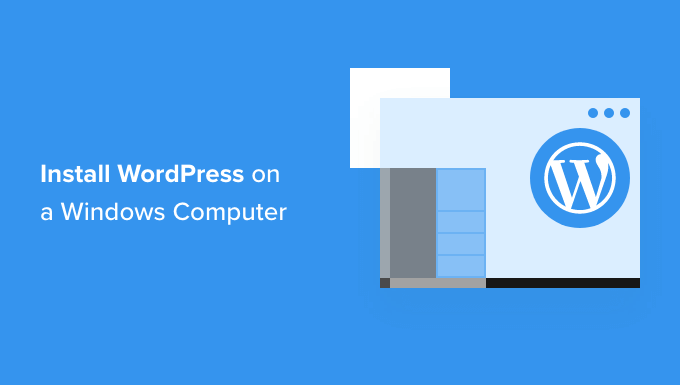
Warum sollten Sie WordPress unter Windows installieren?
Wenn Sie ein Windows-Benutzer sind, dann bietet die lokale Installation von WordPress auf Ihrem Computer mehrere Vorteile.
Eine lokale WordPress-Installation schafft eine Testumgebung, die sich nicht auf Ihre Live-Website auswirkt. Diese Einrichtung, die oft als lokaler Server oder localhost bezeichnet wird, ist Ihr persönlicher Spielplatz für WordPress.
WordPress-Entwickler verwenden regelmäßig lokale Installationen für ihre Arbeit. Zum Beispiel können sie damit mit neuen Plugins oder Themes experimentieren oder die Website vor dem Update auf den Gutenberg-Blockeditor testen.
Aber das ist nicht nur etwas für Profis. Wenn Sie WordPress noch nicht kennen, ist eine lokale Installation perfekt zum Lernen. Sie können Funktionen erkunden, Themes und Plugins testen und frei experimentieren, ohne sich Sorgen machen zu müssen, dass eine Live-Site kaputt geht.
Es ist wichtig zu wissen, dass bei einer lokalen Installation von WordPress unter Windows nur Sie die Website sehen können. Wenn Sie eine öffentliche Website erstellen möchten, benötigen Sie einen Domainnamen und Webhosting.
Technisch gesehen können Sie WordPress unter Windows mit XAMPP installieren, und wir haben bereits eine Anleitung dazu geschrieben.
Wir haben jedoch 2 noch einfachere Methoden als XAMPP gefunden, um eine lokale WordPress-Umgebung einzurichten. Sie eignen sich hervorragend für Anfänger oder Benutzer, die schnell eine lokale Website erstellen müssen. Sie können auf den unten stehenden Link klicken, um zu der jeweiligen Methode zu springen, die Sie interessiert:
Methode 1: WordPress unter Windows mit Studio installieren (schnell und einfach)
Für die erste Methode werden wir Studio verwenden. Dabei handelt es sich um eine lokale WordPress-Software von Automattic, dem Unternehmen, das WordPress.com verwaltet und betreibt, einen Website-Builder, der auf der WordPress-Software basiert.
Wir werden zuerst über diese Methode sprechen, weil sie viel schneller und einfacher zu befolgen ist, was sie perfekt für absolute Anfänger macht.
Zunächst müssen Sie die Website Studio by WordPress.com öffnen. Klicken Sie dann auf die Schaltfläche “Download für Windows”.

Öffnen Sie dann einfach die heruntergeladene Datei, um die Installation zu starten.
Es erscheint nun ein Popup-Fenster, das Ihnen anzeigt, dass die Anwendung installiert wird.
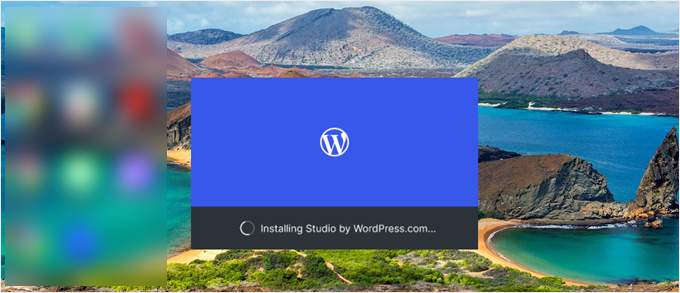
Danach können Sie Ihre erste Website hinzufügen.
Geben Sie dazu einfach den Namen Ihrer neuen lokalen WordPress-Site ein und klicken Sie auf “Site hinzufügen”. Sie können die Website benennen, wie Sie wollen, solange Sie sie leicht identifizieren können.
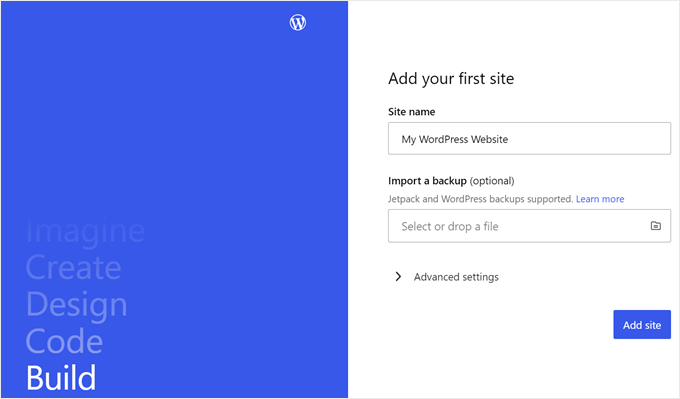
Sie sollten nun das Dashboard Ihrer lokalen WordPress-Website sehen.
Um auf Ihr WordPress-Dashboard zuzugreifen und Ihre Website zu bearbeiten, klicken Sie einfach auf die Schaltfläche “Start” in der oberen rechten Ecke. Dadurch wird Ihre lokale Website für Sie auf Ihrem Computer zugänglich.
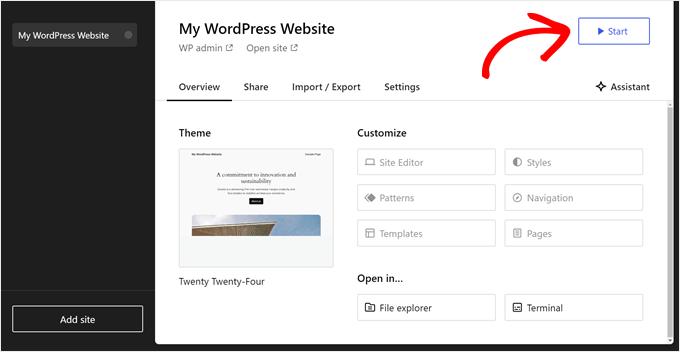
Sobald die Schaltfläche “Start” auf “Läuft” wechselt, können Sie auf den Link “WP Admin” oben links auf der Seite klicken.
Dies bringt Sie zu Ihrer lokalen WordPress-Verwaltungsseite.

Und das war’s dann auch schon mit der Einrichtung. Sehen wir uns nun die anderen Einstellungen an, die beim Aufbau Ihrer lokalen Website erforderlich sein können.
Wie Sie auf der Registerkarte “Übersicht” sehen können, haben Sie direkt vom Studio-Dashboard aus Zugriff auf das Menü des WordPress-Vollseiteneditors. Sie können auch auf “Datei-Explorer” klicken, um die Ordner und Dateien Ihrer WordPress-Website zu öffnen, und auf “Terminal” klicken, um Ihre Website mit WP-CLI zu verwalten.
Wenn Sie zur Registerkarte “Freigeben” wechseln, können Sie sich bei Ihrem WordPress.com-Konto anmelden, Ihre lokale Website klonen und sie auf die Server von WordPress.com hochladen. Dadurch wird die geklonte Website vorübergehend online gestellt, was für die gemeinsame Nutzung von Demoseiten mit Ihren Kunden oder Teammitgliedern nützlich ist.
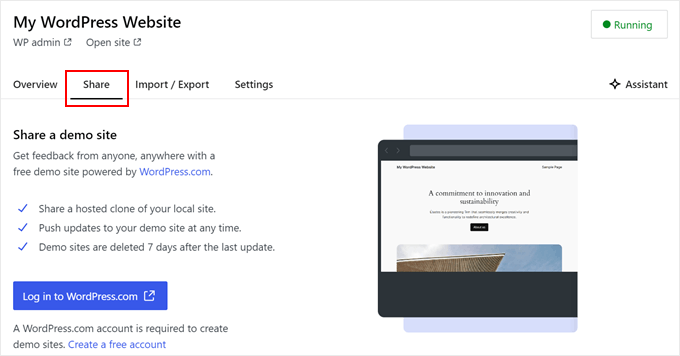
Es kann vorkommen, dass Sie sich direkt über Ihren Browser bei Ihrer lokalen Website anmelden möchten, anstatt Studio zu verwenden. In diesem Fall müssen Sie Ihre wp-admin-Anmeldedaten kennen.
Um sie zu finden, können Sie zur Registerkarte “Einstellungen” wechseln und dort Ihren WordPress-Administrator-Benutzernamen, Ihr Passwort und Ihre Anmelde-URL finden.
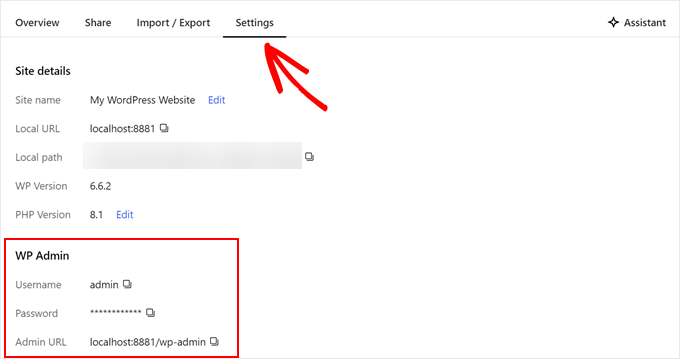
Eine weitere nützliche Funktion von Studio ist der integrierte KI-Chatbot, mit dem Sie kommunizieren können, indem Sie auf die Schaltfläche “Assistent” klicken.
Hier können Sie Studio um Hilfe bei Aufgaben wie der gleichzeitigen Aktualisierung aller Ihrer Plugins, der Aktualisierung Ihrer WordPress-Kernversion oder der Erstellung von Code für einen benutzerdefinierten Block bitten.

Wenn Sie mit der Arbeit an Ihrer lokalen Website fertig sind, bewegen Sie den Mauszeiger einfach über die Schaltfläche “Laufend” in der oberen rechten Ecke, bis dort “Stopp” steht.
Klicken Sie dann auf die Schaltfläche, um die Website zu beenden.

Ein Nachteil von Studio ist, dass Sie die WordPress-Umgebung nicht nach Ihren Wünschen konfigurieren können. Das bedeutet, dass Sie die PHP-Version, den Webserver und die Datenbank verwenden müssen, die für Sie vorausgewählt wurden.
Dies kann ein Nachteil sein, wenn Sie Ihre Website oder Ihr Plugin mit bestimmten Serverkonfigurationen testen müssen.
Wenn Sie mehr Kontrolle über Ihre lokale WordPress-Umgebung benötigen oder Ihr lokales Setup an eine bestimmte Live-Server-Konfiguration anpassen müssen, können Sie die nächste Methode mit Local WP ausprobieren.
Methode 2: WordPress unter Windows mit lokalem WP installieren (besser anpassbar)
Zunächst müssen Sie die Local WP-Software herunterladen und auf Ihrem Windows-Computer installieren. Gehen Sie einfach auf die Local WP-Website und klicken Sie auf die Schaltfläche “Download for Free”.
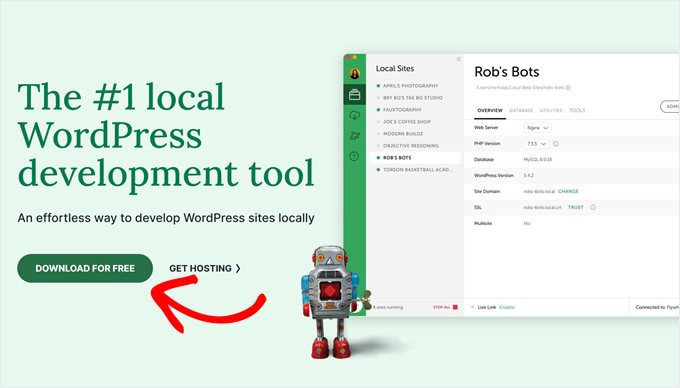
Daraufhin erscheint ein Popup-Fenster, in dem Sie Ihre Plattform auswählen müssen. Wählen Sie “Windows” aus dem Dropdown-Menü.
Als Nächstes können Sie Ihre Daten wie Vor- und Nachname, Arbeits-E-Mail-Adresse und Telefonnummer eingeben, um die Software herunterzuladen.

Nach Eingabe der Daten klicken Sie einfach auf die Schaltfläche “Jetzt anfordern”.
Danach wird die Software automatisch auf Ihren Computer heruntergeladen. Andernfalls können Sie auf den Link “Hier klicken” klicken, um den Download zu starten.

Sobald die Datei heruntergeladen ist, starten Sie den Einrichtungsassistenten.
Nun müssen Sie auswählen, ob Sie die Software für alle Benutzer oder nur für sich selbst installieren möchten.
Sobald Sie eine Option ausgewählt haben, klicken Sie auf die Schaltfläche “Weiter”.
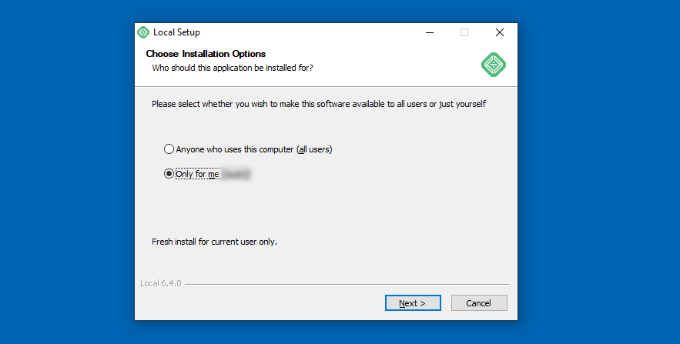
Im nächsten Schritt können Sie den “Zielordner” auswählen, in dem die Software installiert werden soll.
Klicken Sie einfach auf die Schaltfläche “Durchsuchen”, um den Pfad festzulegen, und klicken Sie dann auf die Schaltfläche “Installieren”.
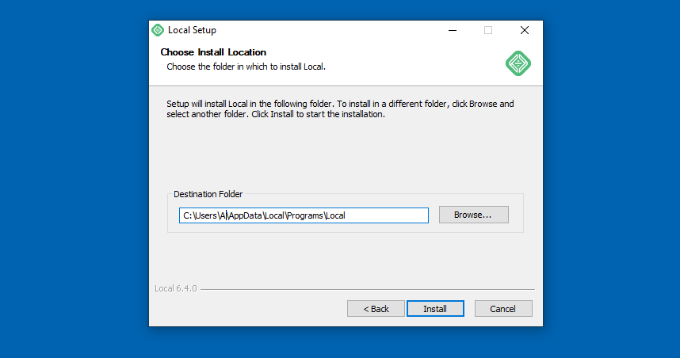
Die Local WP-Software wird nun auf Ihrem Windows-Computer installiert.
Anschließend können Sie das Kontrollkästchen “Lokal ausführen” aktivieren und im Einrichtungsassistenten auf die Schaltfläche “Fertig stellen” klicken.
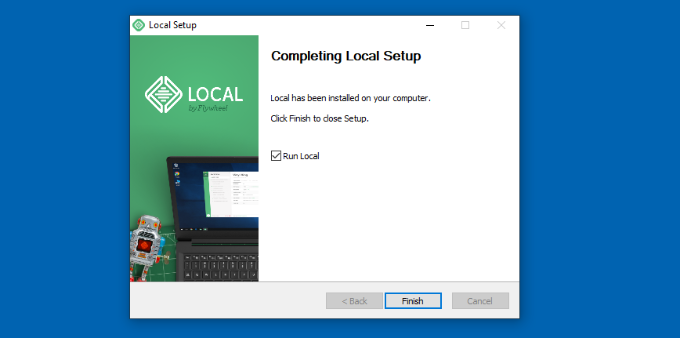
Die Software wird nun auf Ihrem Windows-Gerät gestartet.
Der nächste Schritt besteht darin, eine neue lokale Website hinzuzufügen. Klicken Sie dazu einfach auf das Pluszeichen “+” am unteren Rand.
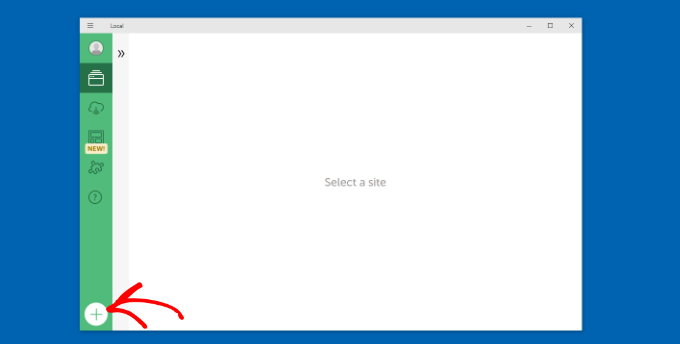
Danach können Sie eine Website in der lokalen Software erstellen.
Wählen Sie die Option “Neue Website erstellen” und klicken Sie auf die Schaltfläche “Weiter”. Es gibt auch die Möglichkeit, die Website aus einer Blaupause oder einer bestehenden Website-Datei zu erstellen, aber zur Veranschaulichung entscheiden wir uns für die erste Option.

Als nächstes können Sie einen Namen für Ihre lokale Website eingeben, z. B. “Meine WordPress-Website”.
Es gibt auch erweiterte Optionen, bei denen Sie die lokale Website-Domäne und den lokalen Website-Pfad eingeben können. Standardmäßig wird für die Domain der Titel Ihrer Website verwendet, jedoch mit Bindestrichen getrennt.
Wenn Sie fertig sind, klicken Sie einfach auf die Schaltfläche “Weiter”.

Danach müssen Sie eine Umgebung für Ihre lokale Website auswählen.
Sie können die “bevorzugte” Umgebung verwenden, in der die Software automatisch die PHP-Version, den Webserver und die MySQL-Version auswählt. Andererseits können Sie auch “Benutzerdefiniert” wählen und die Umgebungsdetails eingeben.
Local WP bietet die neuesten PHP-Versionen. Als Webserver können Sie zwischen Nginx und Apache wählen. Auch bei den Datenbanken können Sie zwischen MySQL und MariaDB wählen.
Beachten Sie, dass einige PHP-, Webserver- und Datenbankversionen das Herunterladen bestimmter Abhängigkeiten erfordern, damit sie ordnungsgemäß funktionieren.
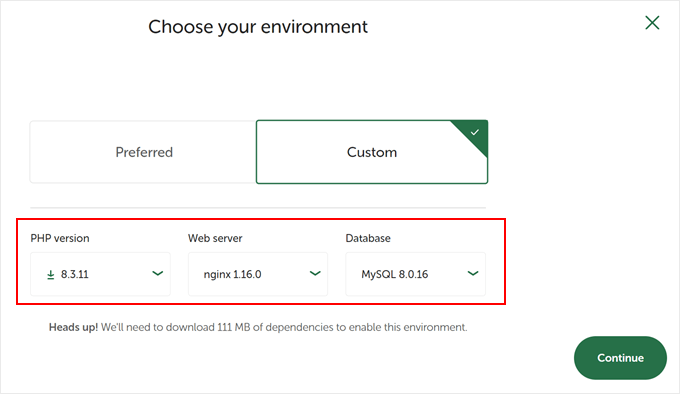
Als nächstes können Sie einen WordPress-Benutzernamen und ein Passwort für Ihre lokale Website eingeben. Außerdem haben Sie die Möglichkeit, eine WordPress-E-Mail-Adresse auszuwählen, an die Sie alle E-Mail-Benachrichtigungen erhalten werden.
Darüber hinaus gibt es eine erweiterte Option, bei der die Software fragt, ob Sie ein WordPress-Multisite-Netzwerk haben. Wenn nicht, klicken Sie einfach auf “Nein”.
Nachdem Sie diese Angaben eingegeben haben, klicken Sie einfach auf die Schaltfläche “Website hinzufügen”.
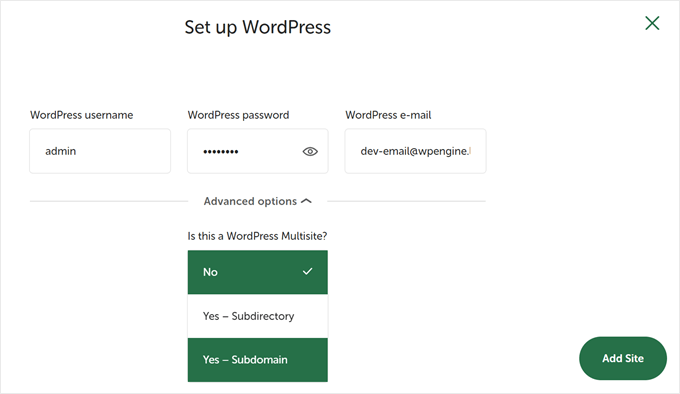
Die Software wird nun WordPress installieren und Ihre Website einrichten.
Um die lokale Website zu starten, klicken Sie auf die Schaltfläche “Website starten” in der oberen rechten Ecke.
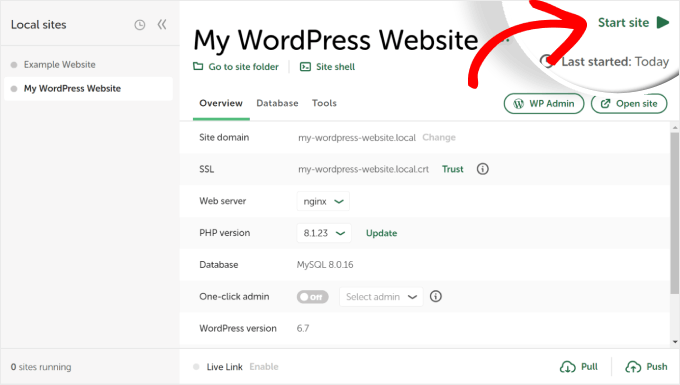
Klicken Sie als Nächstes auf die Schaltfläche “WP Admin”, um die Anmeldeseite für den WordPress-Admin anzuzeigen.
Geben Sie einfach den Benutzernamen und das Kennwort ein, die Sie zuvor bei der Einrichtung der lokalen Website eingegeben haben, und klicken Sie dann auf die Schaltfläche “Anmelden”.

Sie können nun Ihre lokale Website auf Ihrem Windows-Computer bearbeiten.
Wenn Sie fertig sind, vergessen Sie nicht, die Website von der Local WP Software zu stoppen, indem Sie auf die Schaltfläche “Stop site” klicken.
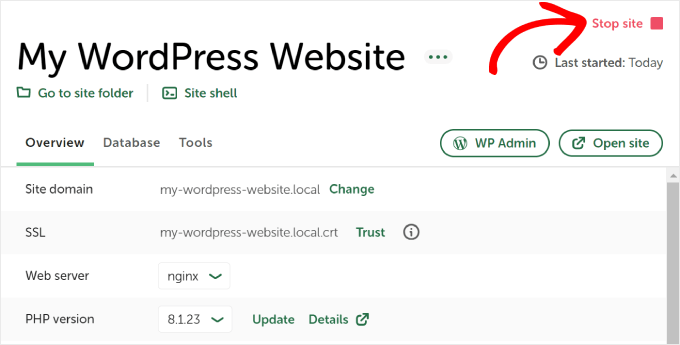
Pro-Tipp: Wenn Sie den Anmeldevorgang überspringen möchten, können Sie in Local WP einen Ein-Klick-Admin-Login aktivieren.
Gehen Sie dazu einfach zurück zum Local WP Dashboard und schalten Sie die Schaltfläche “One-click admin” auf “On”. Wählen Sie dann im Dropdown-Menü den Admin-Benutzer aus, der diese Ein-Klick-Login-Funktion nutzen kann.

Alternative: Verwenden Sie WordPress Playground, um Themes, Plugins und mehr zu testen
WordPress Playground ist ein innovatives Tool, mit dem Sie direkt in Ihrem Webbrowser mit WordPress experimentieren können. Es ist ein virtueller Sandkasten, in dem Sie neue WordPress-Themes, Plugins und Funktionen ausprobieren können, ohne eine reale Website zu beeinträchtigen.
WordPress Playground unterscheidet sich von einer lokalen WordPress-Umgebung in mehreren wichtigen Punkten.
Erstens muss es nicht auf Ihrem Computer installiert werden und wird im Gegensatz zu dauerhaften lokalen Installationen nach jeder Verwendung zurückgesetzt. Sie können von jedem Gerät mit einem Browser darauf zugreifen, während lokale Installationen an einen Computer gebunden sind.
Während WordPress Playground ideal für schnelle Tests und zum Lernen ist, bietet eine lokale WordPress-Umgebung auf Ihrem Windows-Computer mehr Flexibilität für langfristige Entwicklungsprojekte.
Eine ausführliche Anleitung finden Sie in unserem Leitfaden zur Verwendung von WordPress Playground in Ihrem Browser.
Ich habe WordPress auf meinem Windows-Computer installiert, was nun?
Jetzt, wo Sie WordPress auf Ihrem Computer haben, können Sie einige Dinge tun:
- Lernen Sie grundlegende WordPress-Tipps und -Tricks, um Ihre Website besser zu nutzen.
- Probieren Sie verschiedene WordPress-Themes aus, um zu sehen, wie Ihre Website aussehen kann.
- Installieren und testen Sie unverzichtbare WordPress-Plugins, um Ihrer Website neue Funktionen hinzuzufügen.
- Erfahren Sie, wie Sie häufige WordPress-Fehler selbst beheben können.
- Probieren Sie verschiedene Drag-and-Drop-Seitenerstellungsprogramme aus, um Ihre Website ansprechend zu gestalten.
- Erfahren Sie, wie Sie das WordPress-Administrator-Passwort auf localhost zurücksetzen, um den Zugang zu Ihrer Website wiederherzustellen.
- Richten Sie automatisierte Arbeitsabläufe ein, um die Verwaltung Ihrer Website zu erleichtern.
- Erfahren Sie mehr über die Sicherheit von WordPress, um Ihre Website vor Hackern zu schützen.
- Verschieben Sie Ihre lokale WordPress-Website auf einen Live-Server, wenn Sie sie für alle freigeben möchten.
Wir hoffen, dass dieser Artikel Ihnen geholfen hat, zu lernen, wie man WordPress lokal auf einem Windows-Computer installiert. Vielleicht interessieren Sie sich auch für unseren Artikel über die lokale Installation von WordPress auf einem Mac-Computer und unsere ultimative Anleitung zur Erstellung einer WordPress-Staging-Site.
Wenn Ihnen dieser Artikel gefallen hat, dann abonnieren Sie bitte unseren YouTube-Kanal für WordPress-Videotutorials. Sie können uns auch auf Twitter und Facebook finden.





Ruchira
Excellent article. I could install successfully wordpress following this article.
Thank you.
Lindsay
I’m trying to set up a local copy of an existing site. I have a full backup of the site, I have a copy of the database, but when I create a new database in WAMP and try to import the database copy I have, it tells me the database already exists. If anyone can help me figure out what I’m doing wrong I would be very grateful.
Enric
It works perfect!
Christie
ok, got it to work, but trying to install a theme and it gives me error message: The uploaded file exceeds the upload_max_filesize directive in php.ini.
WPBeginner Support
Hi Christie,
Please see how to increase maximum upload size limit in WordPress.
Admin
Christie
I did everything step by step, when opening my local host, it gives me this error message “Error establishing a database connection”. What did I do incorrectly? Thanks!
Sammy P
Excellent tutorial! I am a developer, and totally new to WordPress. And with this tutorial, I was able to set up a complete WordPress test environment on my PC. Thank you!
Nicole
I can’t thank you enough for this help. It worked and walked me through the steps perfectly. Bravo! Cheers to your success in life.
Jacy Lucier
After installing WAMP, a short-cut icon appears on the desktop. It’s not green, and it doesn’t do anything. The real icon used to open WAMP is in the notification area on the task bar – usually at the far right and sometimes, depending on your setup, you must click the up ^ arrow to access it.
Tony
Very helpful article. I installed it and it is running perfect but I am facing an error whenever I Go to Theme/Plugins and click on Add New “An unexpected error occurred. Something may be wrong with WordPress.org or this server’s configuration. If you continue to have problems, please try the support forums.”
or when I go to Setting—>General I see this message on the page “Warning: An unexpected error occurred. Something may be wrong with WordPress.org or this server’s configuration. If you continue to have problems, please try the support forums. (WordPress could not establish a secure connection to WordPress.org. Please contact your server administrator.) in C:\wamp64\www\Ain-Ebel\wp-admin\includes\translation-install.php on line 66”
Can you please assist.
Thanks
Himani Bhardwaj
The only solution I’ve found is to get a better internet connection. Because This Error is so common when an internet speed is slow.
Kiki
Hello,
I get this error after selection a language:
“This program can only be installed on Versions of windows designed for the following processor architectures 64x”
But I tried the 32 en 64 bit version… Can you help?
Aniruddha Chaudhari
I am getting this error:
“The program can’t start because api-ms-win-crt-runtime-|1-1-0.dll is missing from your computer. Try reinstalling the program to fix this problem.”
Any suggestion?
nabil
try installing wamp server version 2.5.
Version 3.0 does not support in some older OS
Saradha
Such a good explanation. Great Work. Thanks!
ian
great info..what my question is…if I decide to make the website with my computer then upload to local site…will the DB still work the same or is code different now..cause I’m on their data base
WPBeginner Support
Hi Ian,
Once you are done with developing your site on your computer, you can move it to a live website.
Admin
Goki
Thank you,such precise explanation
Frank
Went through all of this and it worked fine. Had WAMP running and localhost site running. Was looking at themes. Closed everything down and restarted and now the MYSQL service won’t start. Apache starts and MariaDB starts but mysql won’t start. I’ve searched with google and tried a few solutions but can’t get the issue resolved. I’ve looked in MYSQL log and it’s blank. I’ve tried reinstalling the service and that doesn’t help.
Richard Grove
After renaming wordpress folder and pasting it to the wamp64 folder I get a file 404 error when trying to open browser/ Did I miss a step somewhere? Thanks
Cedric
Hi
Don’t paste the wordpress folder in the general ‘wamp64 folder’
BUT
paste it in the ‘www’ folder inside the ‘wamp64’ folder.
Shabana Anjum Khan
Simple and Easy , thank you
Kim
Great guide, worked like a charm!
vandana
Its really helpful for a novice like me . thanks a lot
ahmad sabry
many thanks it was easy and usefull
Solomon
What else can I say…? This is so informative, and timely. Last week I was struggling to get WordPress installed on my local machine; now it’s done. Good job guys!
Marilyn Mutsune
I really appreciate WP beginner. However, am not tech savvy thus a bit slow on grasping what is probably fundamental for most people.
Now, I got as far as installing Wampserver 64 but when I try http: localhost/my site I get Error 404.
What is the problem? I have done all I possibly can but the error message keeps coming on.
Please help.
Thanks in advance.
Timilz
Ensure there’s no spacing in between local host/mysite
Yogesh Malik
Thanks it is really help full and install the WordPress successfully from above steps.
Tom Martin-Wells
Thanks a bunch for this post, I had been struggling for a while to set up a local server so I could safely test and develop my site, but all the other guides I found never worked. Yours has finally got this sorted for me! Big love.
Marilyn Mutsune
Help! I have been successful to this point but now I can’t rename the folder. The prompt keeps reading, “a file or folder is open in another location.”
Further, I tried pasting http;//localhost/wamp64 in my browser, it gives the error 404. Also, I want to build my website locally before I go live. Please assist me.
Lastly, have mercy this web building stuff is super scary, I just want to write but I need to show case my portfolio. Thus, I have to do this.
Sunday akinola
Great job. Please can we have pdf version of these guides for downloads. Thanks ….
Jeff Collins
After I gave the database a name; it asks me to name a table. I’m not seeing anything like what is on this page after setting a database name.
Nathan Wakefield
Hi guys, I use tutorials all the time, but never felt the need to comment.
Great job! Simple, concise, no need to investigate further on other sites.
Love your work.
Nasredeen
thank you !
Really Helpful…..
Jim Felland
Thank you for the accurate tutorial, this was dead on and walked us right through. Thank you Thank you Thank you
David
Hi,
After coping the wordpress folder to the wamp www folder, I renamed the folder to mysite. When I try to open the url in the browser I get the error message Object not found.
Please advise.
Thanks
David
Carmelo
Please help me what to do after installing wampserver, I opened the phpMyAdmin but its a blank space. It’s not the “Welcome to phpMyAdmin as shown above where I can log in. What do I do. Please. Thanks
PW
Hi,
I want to know if I can share my locally developed site to a friend before pushing it live without having hosting.
amar
thanks for steps. it is really helpful me for installation.
ern
Just wanted to thank you a zillion times for this excellent tutorial, so detailed, i followed it and it went so smoothly!
Leo
I hit a roadblock. I loaded WP in the WAMP folder. Then when it comes to “Now open your web browser and go to localhost/mysite/” Here I copy this address and put it in the address box at the top of the Wamp program (there are two of them side by side…I put it in the right one). Result: Can’t find page. I am stuck…can anyone tell me what I am doing wrong or not doing. Thank you in advance!
Bikash
inside Wamp folder there will be a folder named as www .you need to paste the wordpress folder there and then try it on the browser
Brian
I have downloaded WAMP with the intention of installing WordPress as a local server setup on my Pc. I have a 64 bit CPU on windows 10 and after the installation of the WAMP software, when I click on the desktop icon to launch WAMP, the CMD.exe window briefly appears for a few seconds and then nothing. I have tried both 32bit and 64 bit versions ( installing and then uninstalling) with no success. In the download instructions, it says that for a 64 bit cpu, both 32 bit and 64 bit versions should be downloaded and I have installed both at the same time and i still can’t launch WAMP and I still get the sudden appearance of the CMD screen. Would very much appreciate your help.
Regards,
Brian
Pawan koul
Localhost/mysite is giving a 404 error stating that apache/2.4.23(win 64) PHP/5.6.25 server at localhost port 80.
.help me out.
Amit
i think you have done the same mistake what i have done. actually, we do not have to change www folder name you can change wordpress folder name as you want and keep that inside www folder. it will work. if you still facing same error then i am sorry
Lukasz
Amazing tutorial! Was looking for something like this for ages. Istalled it locally without any troubles and in no time.
I will keep browsing through website as I do my child-theme.
Thank you for your work.
Aly Kouyate
Hello guys I’m a beginner in designing so I try to install wordpress on my windows computer in wamp server the step is:
wamp/www/folther then I chose language the next step I fill form:
Database Name = database
Username = root
Password =
Database Host = localhost
Table Prefix = wp_
When I submit it gave me this error “Can’t select database”
What can I do to remove this error?
Ashutosh Singh
This error show you because you are not make a database with name “database” in phpMyAdmin. So first make a Database in phpMyAdmin of your wamp server. Then Install WordPress and Happy to go with WordPress.
Bikash
Give the database name whichever you have created and try again
Muhammad Adil
Hello Sir !!!
Thank you for sharing such a very useful tip.
I have a question….
I am working with one website locally in my machine. Now I want to start a new project with a new data base name (I can work with several sites with one login but my question is not about that).
For this I create a new data base in my XAMMP server.After that I was unable to login in my WP dashboard again .When I login in WP it takes me to my previous site.
It is necessary to config-php file again ???
please answer
Claire
Please, I tried installing WordPress locally copied the page to the www folder in wamp64 but when I try accessing it through the browser it gives an http 404 error and I haven’t even started the WordPress installation please I need your help on this.
hamork
To have multiple websites on wamp. Do I need to install wordpress in www folder or there’s a specific way to achieve that.
Eugen M
How can I install two/ multiple websites on my PC?
They are not related.
Thank you for your great instructions.
WPBeginner Support
Hi Eugene,
Yes, you can install multiple websites on your PC. Make sure each website has its own folder inside www folder
Admin
Roy Mellick
Problem sorted. I stupidly copied only one of the folders downloaded for WordPress. Sorry to have bothered you. Excellent tutorial, well done.
Roy Mellick
localhost/mysite opens with ‘Index of /mysite’ and not WordPress. Using Wamp64, set up php and database as per your instructions, downloaded WordPress.org v. 4.7.5 from WordPress. Renamed wordpress folder to ‘mysite’.
Any thoughts please.
ajay
I forgot my password, how can I get it back. when I use “lost password” option, it says mail function not enabled. plz help
WPBeginner Support
Hi Ajay,
Please see our guide on How to reset WordPress admin password on localhost.
Admin
John A. Mozzer
I’ve installed Wampserver 3.0.6 on my brand new Microsoft Surface Book with Windows 10. During the installation process, it defaulted to Internet Explorer instead of Edge, and I am not sure what happened with that. I’ve tried launching the program and get a system error message saying it can’t launch because MSVCR110.dll is missing. I hope that I don’t have to uninstall Wampserver and start over. Also, I am new to Windows 10 and can’t tell whether I am looking at the .exe file or the app because extensions don’t show.
Mike
You need to uninstall and read the install notes, you have not installed all the .net Pre recs in the notes follow links.
Margaret
What about Mac users? How to instal WAMP on Apple machine?
WPBeginner Support
Hi Margaret,
Please see our guide on how to install WordPress on Mac using MAMP.
Admin
radhika
Thank you very much. I installed wordpress. Its very helpful
ajay
The wordpress has all themes layout just like blogs. I wanted a standard website layout ? how can I get it
WPBeginner Support
Hey Ajay,
Check out our list of corporate or business themes.
Admin
ajay
Many Thanx buddy. NOw I got few very good themes that I can work upon.